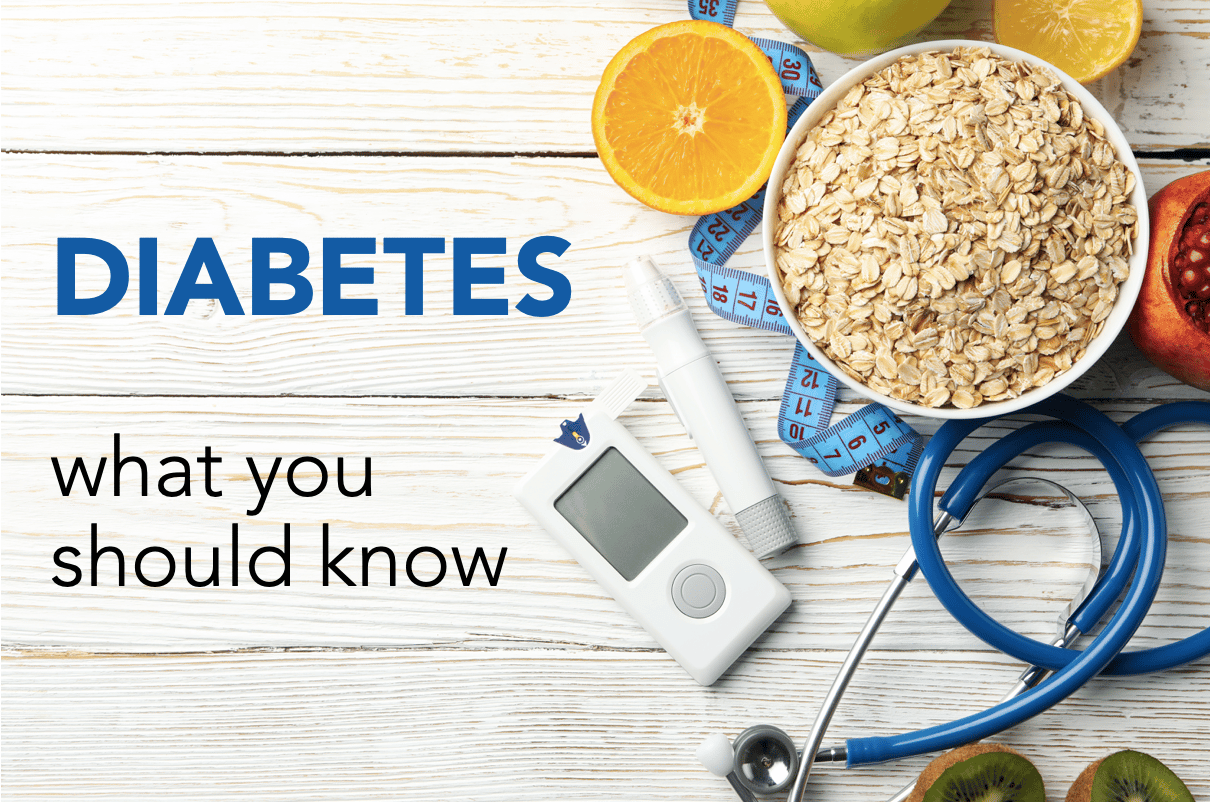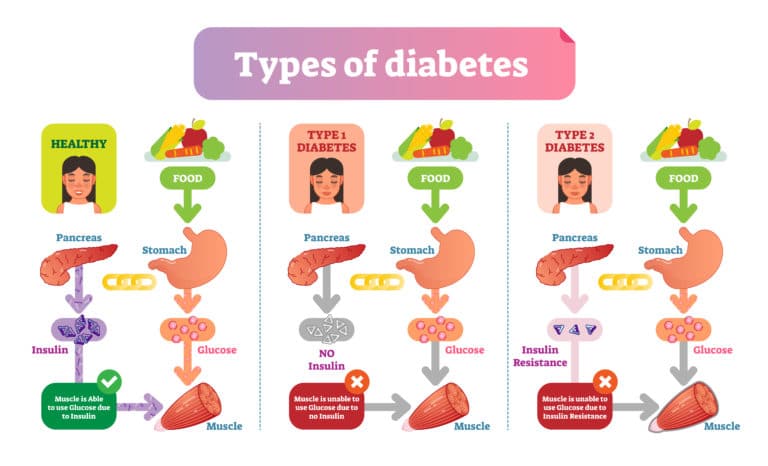Home » Health Education » Diabetes » What You Should Know About Diabetes

What You Should Know About Diabetes
November is Diabetes Awareness Month. If we familiarize ourselves with the risk factors and are intentional about prevention, we can change this statistic.
Diabetes is a major problem in the U.S. According to the CDC, about 10 percent of the U.S. adult population has diabetes and another 34 percent has prediabetes. Together, that’s 44 percent of U.S. adults — almost half of the population — at risk for or living with a disease that is largely preventable. That number is staggering to consider, and while there are many factors at play when it comes to the accessibility of a healthy lifestyle, the vast majority of those cases could have been avoided.
Type 1 and Type 2 Diabetes
Diabetes is a condition in which your body is not effectively using the hormone insulin to regulate your blood sugar. You may already know there are two types of diabetes: type 1 and type 2. If you have type 1 diabetes, your immune system is attacking and destroying the insulin-producing cells in your pancreas. (The pancreas is the flat organ that looks kind of like an elongated, sideways comma and hangs out behind your stomach.) Type 1 often shows up early in life, whereas type 2 is developed over time.
Type 2 diabetes is more common in the U.S. than type 1, and it is typically caused by lifestyle. With type 2 diabetes, your body still produces a small amount of insulin, but it isn’t effective enough. The pancreas can’t keep up with the high blood sugar levels resulting from poor diet and lack of exercise. Some people with type 2 diabetes actually have “insulin resistance,” which means the pancreas produces insulin but the body does not recognize it (this is different from type 1, in which the insulin-producing cells are being attacked by the immune system). You can learn more about the differences between these two here.
Prediabetes is the condition in which your blood sugar is higher than normal, but not high enough to be considered type 2 diabetes. The good news is prediabetes is completely reversible with the right diet and lifestyle changes.

Know the Risk Factors
There are several risk factors for type 2 diabetes. The following characteristics or experiences mean you should keep an eye out for symptoms and make sure you’re doing everything you can to stay healthy:
- Age 45 or older
- Family history of diabetes (mother, father, or siblings)
- Certain ethnicities are at higher risk: African Americans, Hispanics, Asian Americans and Pacific Islanders, American Indians, and Alaska Natives are at an increased risk for developing diabetes
- Women who have experienced gestational diabetes, which is diabetes that occurred during pregnancy. This would include women who delivered a baby weighing nine pounds or more at birth.
- Being overweight with a BMI of 25 or higher
- Adults who are physically inactive
- Lipid panel analysis that indicates low HDL (good) cholesterol, and high levels of triglycerides
- High blood pressure
- Women who have been diagnosed with polycystic ovarian disease
Early Warning Signs for Diabetes:
Being familiar with the early warning signs of diabetes will help you be prepared and know whether or not to get a screening. The following are some common symptoms of diabetes to look out for:
1. Blurred vision
Your eyes are extremely sensitive to elevated blood sugar levels. Having too much sugar in your blood weakens the vessels in your eyes and can even damage your retinas. The vessels can bulge and even form mini-aneurysms inside the eye. During the early stages of diabetes, blurry vision can come and go. It isn’t until later that the damage can become permanent.
Blurry vision can be temporary, returning to normal in as little as a day. Because of this, many people are tempted to ignore the problem. However, it is important to go see a doctor immediately if you are experiencing blurred vision.
2. Increased hunger
When your body has too much sugar in it, the sugar can’t enter the cells that need it. In some cases, this is due to insulin resistance or a lack of insulin. Insulin is what transports glucose (or blood sugar) throughout your body. When the cells of your body don’t have the glucose they need to function, they send out a signal to your brain that makes you hungry. However, eating will only cause a further buildup of glucose if the blood sugar isn’t lowered first.
Diet plays the biggest role in this particular issue. Sweets and foods loaded with artificial sugar will do nothing to make you feel full while causing your blood sugar levels to skyrocket. If foods high in processed sugar are a major part of your diet, it can lead to a vicious cycle of eating constantly but never getting the nutrients your body needs while further elevating blood sugar.
3. Increased thirst
Increased thirst seems like it would have a similar cause to increased hunger, but it actually occurs for a very different reason. Your kidneys are responsible for processing glucose in your body. When there is too much glucose for your kidney to handle, the excess gets sent out through urine. In the process, fluids are actually pulled from the surrounding tissues, which makes you feel dehydrated.
In this case, feeling thirsty has nothing to do with how much water you are drinking, but how well your kidneys are able to process the amount of blood sugar in your system. If blood sugar levels don’t return to normal, no amount of water will make you feel hydrated for very long.
4. Tingling
Blood sugar levels also have an effect on the nervous system. This is most usually seen in the places farthest from the body — the hands and feet — because blood has to travel the farthest to get there. Too much blood sugar can cause them to not work as well, damage them, or cause them to go completely numb. Any tingling or numbness in the hands and feet should be looked at immediately.
5. Slow-healing wounds
This is also a result of having damaged nerves. If the body’s nerves are damaged because they aren’t getting enough blood, it reduces their ability for your body to begin to heal itself. Getting healthy, oxygenated blood to a damaged area is essential to the healing process.
In the worst cases, some diabetics experience neuropathy, which is when the nerves die. This is dangerous because people will completely lose feeling in a part of their body (usually the feet) and will be unaware if they get hurt. People with neuropathy can walk around for weeks with a wound without knowing it, making it progressively worse.
6. Fatigue
This can be a difficult one for many people because fatigue can be caused by many different things. You might attribute it to a lack of sleep or stress — both of which could be true. A number of other illnesses or factors can also cause fatigue.
However, if you are experiencing fatigue alongside any of these other symptoms, it should definitely be treated as another warning sign that you may be developing, or already have, prediabetes.
Think you might be at risk for diabetes?
At Life Line Screening, we offer a simple diabetes test (called an A1C panel) that can be done quickly and easily. With just a finger prick, we can measure the amount of glucose in your blood and tell you if you are at risk of being prediabetic or developing type 2 diabetes. We’ll also give you your results so you can share them with your doctor.
If you’re unsure or feel you may exhibit the risk factors, learn more about Life Line Screening’s A1C home test kits today, or schedule a screening and get informed about your health.
References
“National Diabetes Statistics Report, 2020.” Centers for Disease Control and Prevention, 2020.
“Eye damage with diabetes.” Kaiser Permanente, 01/03/19.
“Diabetes symptoms: When diabetes symptoms are a concern.” Mayo Clinic, 05/25/19.
Learn more or schedule a screening today at lifelinescreening.com — or give us a call at 800.718.0961. We’d love to help.
Topics:
Diabetes